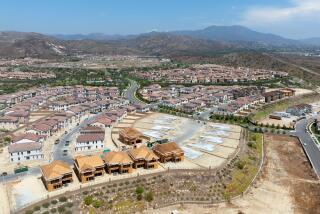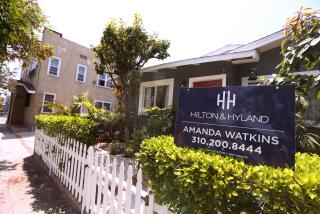Silicon Beach housing prices surge as techies move in
- Share via
In Venice, 25-year-old Snapchat co-founder Bobby Murphy has bought a new two-bedroom house for $2.1 million, or nearly double the median price of homes in the neighborhood.
A few blocks away, a three-bedroom town house with a rooftop sun deck was just rented for $7,000 a month — a year ago, an identical unit was renting for $5,900. “Totally Silicon Beach living,” the ad on Craigslist proclaimed.
And farther south in Marina del Rey, hundreds of apartments were recently completed and aimed at drawing the tech crowd, with high-speed Internet in every unit, free Wi-Fi in common areas and an online application process.
The Westside has long been a desirable place to live, attracting entertainment executives, sports stars and financial gurus. But there’s a new guard moving in.
The burgeoning tech community known as Silicon Beach is fueling a Westside housing grab that has enabled landlords to push sky-high rents even higher and helped send home prices above their pre-recession highs. Real estate agents say that within these neighborhoods, techies have made a brutal real estate market for buyers and renters even tougher.
“Everyone wants to buy here because this is the hot, cool space,” said Brian Maser, a real estate agent who specializes in selling condos in the area.
Amid last decade’s housing bubble, the median home price in Silicon Beach — the area west of the 405 Freeway from Santa Monica south to Marina del Rey — peaked at $925,000 in the second quarter of 2007 before plummeting 25% to $694,000 in the first three months of 2010, according to research firm DataQuick.
But Silicon Beach prices have risen sharply this year. The median price in that area reached $952,500 last quarter, 19.2% higher than in the same period last year.
Overall housing prices in Southern California, meanwhile, are still far below their peak during the bubble.
Tami Pardee, principal of Pardee Properties in Venice, said tech workers from Silicon Beach have descended upon the Venice market, and her agents have been busy showing homes to employees of Google and Facebook. She estimated that 30% of her buyers work in the industry.
“They have the money to buy,” she said. “We’re excited but cautious.”
As more techies move into the Westside, there are fears that the area — and especially the eclectic, funky vibe in Venice — could go from charmingly quirky to overly techie.
In a recent report, commercial real estate brokerage Marcus & Millichap found signs that renters “are beginning to balk at the area’s high rents,” which may be forcing some people to other regions.
“We want Venice to remain Venice,” longtime Westside resident Briana Chalais, 35, said. “We don’t want to be overtaken by all tech people.”
These days, the tech influx can be seen up and down the Westside.
Two years ago, Google expanded its Southern California presence by opening a campus in Venice, leasing 100,000 square feet in three buildings for hundreds of employees. Other tech behemoths, including Facebook, also have sizable operations nearby; in September, Microsoft opened a roughly 20,000-square-foot space in Playa Vista to house 130 employees who had previously been in downtown L.A.
At the same time, smaller tech firms, attracted by the proximity to the beach and the comfortable distance away from cutthroat Silicon Valley, settled in along the Westside. Start-up accelerator programs and incubators followed, and the surge in entrepreneurial activity attracted interest from investors, who opened local offices.
As the tech community swelled in number, many zeroed in on nearby housing.
Alex Cochran manages the L.A. office for Palantir Technologies, a Silicon Valley software firm that helps companies and governments analyze data. When the company outgrew its downtown L.A. office, it left behind the corporate US Bank Tower and set up shop this spring near Santa Monica’s Third Street Promenade.
Cochran and his wife then focused their home search nearby. There was an added incentive: Palantir offers its employees a housing subsidy of a few hundred dollars a month to live near the office.
This summer the couple purchased a two-bedroom Santa Monica condo for $749,000.
“I can work remotely, pop in at the office, run home and not have to trek across town,” said Cochran, 31. “It incentivizes community. Your co-workers aren’t just co-workers but also neighbors.”
This week Snapchat’s Murphy, who in recent weeks turned down a $3-billion offer from Facebook for his popular photo-messaging app, purchased the $2.1-million Venice home that is blocks from the start-up’s headquarters.
Nikki Hochstein of Rodeo Realty said such techies are “making it harder” for others to break into the market.
“Venice prices are going through the roof,” she said, “which is pushing people into Mar Vista and south Santa Monica.”
Hochstein said sellers she represents often ask her for a favor — “Why don’t you go down to Google and just drop off postcards there?” — but she hasn’t had to yet: She’s had no trouble selling a house.
It’s not just home prices that are going up. Landlords in the area have benefited too.
The average apartment rent on the Westside was $2,401 a month in the third quarter, 5.3% higher than a year ago and nearly 20% above its recessionary trough, according to Marcus & Millichap.
In contrast, the average apartment rent in Los Angeles County was $1,688 a month in that quarter, up 2.6% year over year.
The tech effect on Westside housing prices isn’t nearly as pronounced as it is in San Francisco, which has been inundated in recent years by droves of young, affluent techies working for Google, Apple, Facebook, Twitter and other hot companies.
That’s led to a growing divide in San Francisco between the high-tech elite and non-techies, and raised fears that Silicon Valley’s riches aren’t spilling over into the rest of the economy.
Although many longtime Westside residents lament the fast-paced gentrification that has permeated through Venice and neighboring areas in recent years, that resentment hasn’t focused on the tech crowd, in part because Silicon Beach is still relatively small.
Companies such as Google and Snapchat have garnered much of the attention, but most people in Silicon Beach toil away at little-known start-ups. The tech workforce is predominantly young, and although many developers take home a nice paycheck, that income can shrink fast in an area with a median home price of nearly $1 million.
Because of that, many entrepreneurs prefer to remain renters. But the tech scene has undoubtedly created massive hype for the Westside and boosted housing demand and prices.
Other businesses have sprung up, hoping to piggyback on the tech wave. Trendy restaurants and boutiques have moved in, in part to be close to those working on the latest mobile app.
“The seats in our cafe are almost always occupied by tech start-up people. This whole place has become like another office for Silicon Beach,” said Matt Semler, 27, who works at the Toms retail store and coffee shop on Abbot Kinney Boulevard in Venice.
But as the already crowded Westside gets more popular, even techies are being priced out.
Jerry Jao, co-founder and chief executive of Santa Monica start-up Retention Science, said he hired a real estate agent three months ago to help him buy a condo near work. He soon scrapped that plan, however, opting to stay in his rented three-bedroom apartment with two roommates.
“Prices have gone up too much,” he said. “Everything on the Westside is too ridiculous.”
More to Read
Inside the business of entertainment
The Wide Shot brings you news, analysis and insights on everything from streaming wars to production — and what it all means for the future.
You may occasionally receive promotional content from the Los Angeles Times.










